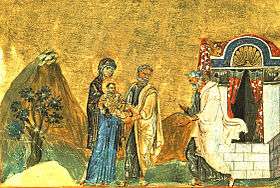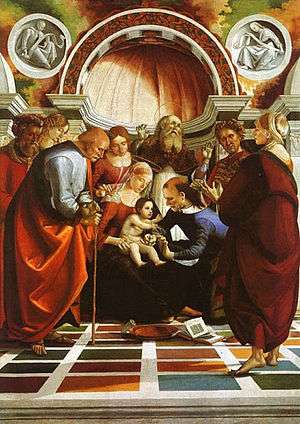Feast of the Circumcision of Christ

The Feast of the Circumcision of Christ is a Christian celebration of the circumcision of Jesus in accordance with Jewish tradition, eight days (according to the Semitic and southern European calculation of intervals of days)[1] after his birth, the occasion on which the child was formally given his name.[2][3]
The circumcision took place, not in the Temple, though painters sometimes so represent it, but in the home.[3]
The circumcision of Jesus has traditionally been seen, as explained in the popular 14th-century work the Golden Legend, as the first time the blood of Christ was shed, and thus the beginning of the process of the redemption of man, and a demonstration that Christ was fully human, and of his obedience to Biblical law.
The feast day appears on 1 January in the liturgical calendar of the Eastern Orthodox Church.[4] In the General Roman Calendar, the 1 January feast, which from 1568 to 1960 was called "The Circumcision of the Lord and the Octave of the Nativity", is now named the solemnity of Mary the Holy Mother of God and the Octave Day of the Nativity of the Lord. It is celebrated by some churches of the Anglican Communion and virtually all Lutheran churches. In these latter Western Christian denominations, the Feast of the Naming and Circumcision of Jesus Christ marks the eighth day (octave day) of Christmastide.[5]
Eastern Orthodox Church
The feast is celebrated with an All-Night Vigil, beginning the evening of December 31. The hymns of the feast are combined with those for Saint Basil the Great. After the Divine Liturgy the next morning, Russian Orthodox churches often celebrate a New Year Molieben (service of intercession) to pray for God's blessing for the beginning of the civil New Year (Orthodox commemorate the Indiction, or Ecclesiastical New Year, on September 1).
On the Julian calendar, 1 January will correspond, until 2100, to 14 January on the Gregorian Calendar.[6] Accordingly, in Russia, 14 January in the civil calendar is known as "The Old New Year", since it corresponds to 1 January in the Julian Calendar, still used by the Church.

Catholic Church
At an early stage the Church in Rome celebrated on 1 January a feast that it called the anniversary (Natale) of the Mother of God. When this was overshadowed by the feasts of the Annunciation and the Assumption, adopted from Constantinople at the start of the 7th century, 1 January began to be celebrated simply as the octave day of Christmas, the "eighth day" on which, according to Luke 2:21, the child was circumcised and given the name Jesus. In the 13th or 14th century 1 January began to be celebrated in Rome, as already in Spain and Gaul, as the feast of the Circumcision of the Lord and the Octave of the Nativity, while still oriented towards Mary and Christmas.[7] The emphasis that Saint Bernardine of Siena (1380–1444) laid on the name of Jesus in his preaching led in 1721 to the institution of a separate Feast of the Holy Name of Jesus. Pope John XXIII's 1960 rubrical and calendrical revision called 1 January simply the Octave of the Nativity. (This 1960 calendar was incorporated into the 1962 Roman Missal, whose continued use is authorized by the motu proprio Summorum Pontificum.) The 1969 revision states: "1 January, the Octave Day of the Nativity of the Lord, is the Solemnity of Mary, the Holy Mother of God, and also the commemoration of the conferral of the Most Holy Name of Jesus."[8]
Anglican communion
The Anglican communion's Book of Common Prayer liturgy celebrates this day as the Circumcision of Christ.
Since 2000, the Common Worship of the Church of England lists this day as the "The Naming and Circumcision of Jesus Christ."
The Book of Common Prayer of the Anglican Church of Canada calls it "The Octave Day of Christmas, and the Circumcision of Our Lord, being New Year's Day".
Lutheran Church
Since it was a feast of Christ and related directly to Scriptural passages (notably Luke 2:21), the Feast of Circumcision was retained by churches of the Lutheran Reformation. It remains on most Lutheran liturgical calendars to this day, although there has been a general move to call it "The Name of Jesus."[9] Martin Luther preached at least one notable sermon on this feast day which is still available in his Church Postils, and up until the late 1970s, Lutheran hymnbooks would contain several hymns relating to this subject.
See also
References
- ↑ In the northern European calculation, which abstracts from the day from which the count begins, the interval was of seven days.
- ↑ Luke 2:21 (King James Version): "And when eight days were accomplished for the circumcising of the child, his name was called JESUS, which was so named of the angel before he was conceived in the womb."
- 1 2 Catholic Encyclopedia: Feast of the Circumcision
- ↑ Greek Orthodox Archdiocese calendar of Holy Days
- ↑ MacBeth, Sybil (1 November 2014). The Season of the Nativity. Paraclete Press. p. 113. ISBN 9781612616131.
January 1, New Year's Day, is also the eighty day of Christmas. On the eighty day of life Jewish boys have a circumcision ceremony, or bris. January 1 is the Circumcision of Christ and the Feast of the Holy Name.
- ↑ Russian Orthodox Church, Patriarchate of Moscow
- ↑ Adolf Adam, The Liturgical Year (Liturgical Press 1990 ISBN 978-0-81466047-8), pp. 139–140
- ↑ Universal Norms on the Liturgical Year and the Calendar, 35 f
- ↑ As in the Lutheran Book of Worship, page 10. Copyright 1978, Augsburg Fortress.,
External links
| Wikimedia Commons has media related to Circumcision of Jesus Christ. |
- Russia Orthodox explanation of The Circumcision ("Obrezanie") of the Lord
- An essay on the feast of the circumcision from Anglicans Online